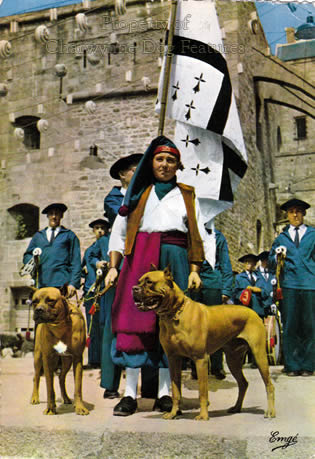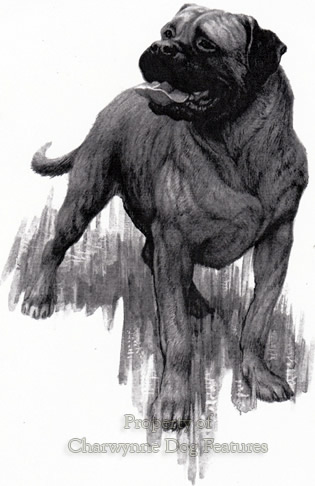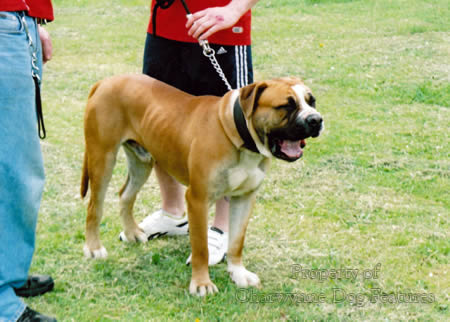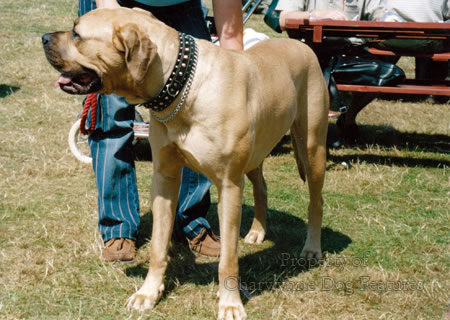847 THE FUTURE OF PROTECTIVE DOGS
THE FUTURE OF PROTECTIVE DOGS
by David Hancock
 What arrogance modern man displays, and what ignorance too, in brushing aside the choice of property owners for centuries of the mastiff group as canine sentries, choosing instead breeds with quite the wrong instincts. When I see snarling police dogs or hear endlessly-barking, so-called "guard-dogs", I wonder why such fearful aggression is not seen through. WD Drury, in his British Dogs of 1903, wrote: "Many are under the impression that what is required in a night-dog is ferocity. No greater mistake could be made, as those who have witnessed the work of night-dogs, alike in this country and abroad, can testify. Strength, a good dark colour, and the knowledge of how to floor an 'undesirable' are essentials in any night-dog...found naturally in the Mastiff."
What arrogance modern man displays, and what ignorance too, in brushing aside the choice of property owners for centuries of the mastiff group as canine sentries, choosing instead breeds with quite the wrong instincts. When I see snarling police dogs or hear endlessly-barking, so-called "guard-dogs", I wonder why such fearful aggression is not seen through. WD Drury, in his British Dogs of 1903, wrote: "Many are under the impression that what is required in a night-dog is ferocity. No greater mistake could be made, as those who have witnessed the work of night-dogs, alike in this country and abroad, can testify. Strength, a good dark colour, and the knowledge of how to floor an 'undesirable' are essentials in any night-dog...found naturally in the Mastiff."
A police dog-handler of eighty years ago in Norfolk once wrote: "Personally I want no better dog than a bullmastiff for police work and I am ready to back it against any other breed...A gamekeeper friend recommended it to me, and said I should never regret having one. His words were true." Before the Great War, Count VC Hollander, who knew a thing or two about dogs, recorded this little incident: "...Mr and Mrs Bennett had gone to a party, leaving the children in the charge of the maids. A man forced his way into the house; one of the maids loosed a dog, a bullmastiff, who held the man from nine o'clock in the evening until Mr. and Mrs. Bennett returned in the early morning." If your ancestors could pin a bull, what's the problem with a mere man!
I have described, elsewhere on the site, my experience in using two Bullmastiffs to patrol the 1,000 acre estate that I once managed. Silent operators with good scenting powers, they were perfect for the task. I am a great believer in breeds of dog still being able to carry out their original function, even if we don't need them to. If they simply cannot, then in my book they do not belong to that breed. Only in this way can we keep a breed in touch with its roots and retained as a functional useful animal as opposed to a mere ornament. The strong ‘seizing and holding’ instincts of the Gamekeeper’s Night-dog are still available to us; these are not noisy watchdogs or savage sentinels but dogs that use controlled aggression in an acceptable way. They merit greater recognition and wider use.
Use of Senses
I would like to see a move away from the rather arbitrary division of hound breeds into scent or sight hounds. All hounds hunt by sight at times and versatile hounds like the Ibizan use their ears, noses and eyes to equal effect. A better separation would be between those which hunt using stamina, like most of the scent-hounds, those which hunt mainly using their sheer speed, like the sight-hounds, those which hunted using scent and sight as par force hounds (like the Great Dane) and those which were employed 'at the kill', as holding and seizing hounds. This would bring the hunting mastiffs into the Hound Group, but more importantly bring them under judges who are used to assessing animals which were designed to hunt their prey. Movement, athleticism generally, and probably feet and 'bite', would soon improve. Recognising mastiff breeds as hounds would undoubtedly improve their health and their ability to enjoy life - with a much more athletic physique. If this requires the introduction of outside blood, then that would just be a repeat of history, that is how they were 'made'!
Alien Forms
But the choice of breeding material should be based surely on need, not dogma. In recent years I have seen quite a number of 'Mastiffs', bred by artisan breeders, that conformed to the type depicted in so many 17th, 18th and early 19th century portrayals. One was a Mastiff-Staffie cross and another a Mastiff-Bullmastiff cross. The Mastiff of the show ring is for me a fawn Alpine Mastiff, lacking the anatomy of our famous native breed. That may not be surprising, bearing in mind the blend of breeds behind the Mastiff's re-shaping in the 19th century, but is it historically correct? Once, at an Irish Wolfhound ring, I watched a shaggy exhibit for a while and then remembered where I had seen that 'look' previously - in the depiction of an early importation of a Tibetan Mastiff. Capt Graham, re-creator of the Irish Wolfhound used a Tibetan Mastiff sire 'Wolf' on the wolfhound 'Tara' and their offspring appear in the pedigree of every modern Irish Wolfhound.
It is always a risk when crossing two breeds or introducing outside blood into a breed that too much of one feature will crop up in time to the detriment of true breed type. A closed breed gene-pool is unlikely to provide redress. Only once have I detected this 'Tibetan Mastiff look' in an Irish Wolfhound, but I see the 'Alpine Mastiff look' in every contemporary Mastiff ring I view. When long-haired Mastiffs crop up in litters, they look very much like the Livestock Protection Dog breeds. The Mastiff of England was a hunting dog, a hound; the Alpine Mastiff was a mountain dog, requiring bulk and less athleticism. The mountain dog anatomy is now dominant and in my view true type has been lost in this famous native breed. But the breed fanciers seem happy with their stock, which is disappointing. The Mastiff is a feature of our canine heritage and should not be represented by an alien form. If this breed has been 're-created' once and that action condoned, why can't it be done again and with greater historical accuracy this time?
Recognising Service
The mastiff breeds, whether huge like the Mastiff of England, as small as the Bulldog of Britain, cropped-eared like the Cane Corso of Italy and the Perro de Presa of the Canaries, loose-skinned like the Mastini of Italy or dock-tailed and cropped-eared like the Boxer of Germany in many countries, are not only fine examples of powerful but good-tempered dogs but form part of their respective nation's canine heritage. It is vital that they do not fall victim to show ring faddists or misguided cliques of rosette-chasing, over-competitive zealots. A giant Mastiff which can hardly walk, a muzzle-less Bulldog which can hardly breathe and a Bullmastiff dying young from an avoidable inherited disease are all sad reflections on the moral sterility of the last two centuries’ breeders. In the English breed of Mastiff, a new approach is desperately needed; my own plan to assure this fine breed a better future would be based on this: 
Six Point Plan For The Restoration of the True Mastiff of England
1. Amend the Breed Standard to omit harmful or untypical features, e.g. pursuit of great size, the word 'massive', short muzzle, small eyes, heavy forequarters, restricted coat colours and any mention of wrinkle - except to forbade it.
2. Brief specialist breed judges and as many all-rounders as you can to dismiss from the ring: lamentably unsound or exhibits that breach the Standard e.g. sunken eyes, seriously overweight, limp tails, huge ears, heavy forehead, appalling movement. If you truly love the breed, be assertive!
3. Hold seminars to highlight the madness of continuing to breed Mastiffs with dippy backs, straight stifles, size at the expense of soundness and dreadful movement.
4. Breed out the 'mountain dog look'; it comes from alien blood introduced in the 19th century. A Mastiff should never look like a fawn St Bernard. Long-haired specimens indicate the presence of this blood, or that of the Leonberger, in the gene pool.
5. Form a Restoration Working Party of real Mastiff devotees to get the breed back on track - before some political body does it for you, like the IFAW-influenced European Council. Be aware of the morality poseurs/animal welfare activists at work nowadays, they are vocal, dedicated and not breed lovers!
6. Accept that pied, solid-white and solid black Mastiffs can be purebred and admitted to the stud book. (I have referred elsewhere to the Gammonwood pieds and Daisy, a purebred white Mastiff registered with the AKC as a Mastiff. The pied dog Dozer in Australia has Jenglen and Bredwardine on both sides; this is no stigma on those kennels whatsoever, they are not responsible for the appearance of a different coat colour - read Wynn to find the origin!)
Each recognised mastiff breed, and not just the Mastiff of England, merits such a plan for its restoration to true type and role-recognition.
Honouring Heritage
May 21st century breeders wake up to such unacceptable excesses, honour the proud heritage of these distinguished breeds and respect them for what they are: the light heavyweights of the canine world, quick on their feet and devastating at close quarter protection when threatened. They are not mountain dogs or draught dogs needing massive bone but strongly-built hounds with their own distinct type, that must be conserved. Contemporary attitudes no longer support the use of fierce dogs to hunt wild animals. That I support. But there could still be a role for brave determined dogs to be used to ‘seize and hold’ animals such as escaped rampaging cattle or feral wild boar endangering human beings, where this removes the requirement to shoot and kill them. There is a huge difference between wild animals being savaged by a pack and their being detained by trained dogs, under strict control, for their own long-term good. There is a risk however of dogs being employed in such an historic role themselves being harmed. There is a judgement to be made here in the best interests of the quarry and the dogs. Such magnificent canine athletes deserve the very best custodianship, with every fancier respecting their hound ancestry, remembering their bravery at man's behest and revering their renowned stoicism. Long live the mastiffs of the world!